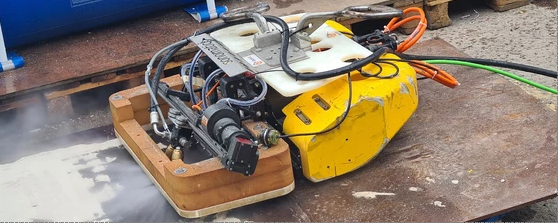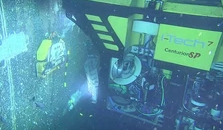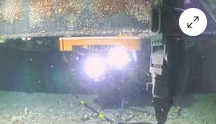Experts in inspection, Sonomatic have combined their ability to build bespoke tools and adapt current ones to fit unique situations for years.
Recently, when a corrosion risk assessment was conducted on a client’s large subsea oil storage tank located on the seabed, in water depths in excess of 130m, Sonomatic demonstrated their innovative capabilities.

The tank structure had a total surface area of 8550m². Each face of the tank required inspection for potential corrosion threats, including the bottom of the tank which is 1m above the seabed on a support frame. Due to the limited access to the tank bottom, it was inaccessible for most ROV systems to conduct/deploy an inspection system capable of collecting accurate corrosion mapping information. The tank has been in service for some time and had a build- up of marine growth and seabed silt on all surfaces. Any inspection solution had to be capable of conducting cleaning operations to obtain an acceptable scan surface condition and provide accurate thickness measurements required to satisfy the CRA requirements.

Although the MAG-Rover is a tried and tested system for automated ultrasonic subsea inspection, the capacity to conduct simultaneous cleaning and phased array inspection operations on the structure was a new challenge for Sonomatic. An intense development process for a water jetting cleaning head was completed before the MAG-Rover was put into action on the top face of the tank and commenced cleaning and phased array corrosion mapping data collection on selected runs covering 109.5m. The MAG-Rover continued an intense cleaning and inspection campaign on all four sides, and the top and bottom faces of the tank. Due to the high risk associated with the inspection on the bottom of the tank, runs were conducted in a safe and tightly controlled evolution, managed by all parties. In total, over 700m of data was collected on all faces of the tank. The accurate phased array corrosion mapping data sets will provide sufficient information to satisfy the CRA requirements to show that the tank will be fit for purpose for several years to come.
Using the right technique in the right situation is critical when it comes to advanced NDT. Sonomatic’s proven experience in specialised inspections allows the company to analyse each situation individually and offer the best inspection method for the job.

Graham Marshall, Subsea Project Manager at Sonomatic, said: “This was far from a standard operation for Sonomatic as inspection specialists, however we have been considering cleaning applications for some time and this was an ideal project to support our development. A push from the client to reduce offshore inspection times required us to consider simultaneously cleaning and gathering ultrasonic inspection data at the same time in one pass. This was challenging due to the debris from the marine growth removal, blocking scanner workings, and possibly getting stuck in the ultrasonic probe travelling behind the cleaning nozzles.
“The application was a success, and the client was very satisfied with the productivity of the scanner and the ability to reduce offshore time by simultaneously cleaning and inspecting.”
Videos can be found here:









